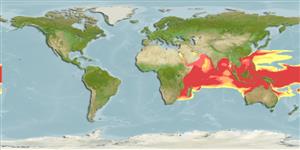Teleostei (teleosts) >
Beloniformes (Needle fishes) >
Exocoetidae (Flyingfishes)
Etymology: Parexocoetus: Greek, para in the side of + Greek, exos = outside + Greek, koite = hole (Ref. 45335).
More on author: Valenciennes.
Environment: milieu / climate zone / depth range / distribution range
Ecology
Marine; pelagic-neritic; oceanodromous (Ref. 51243); depth range 0 - 20 m. Tropical; 30°N - 23°S, 20°E - 178°W
Indo-Pacific: widespread from East Africa, including the Red Sea and the Gulf, to southern Japan, Marshall Islands, Fiji, the Arafura Sea (Ref. 9819) and Queensland, Australia. Migrated to eastern Mediterranean through the Suez Canal (Ref. 6523). Presence in Somalia to be confirmed (Ref. 30573). Records from the Atlantic (as Parexocoetus mento atlanticus) are in error.
Size / Weight / Age
Maturity: Lm ? range ? - 13 cm
Max length : 11.0 cm SL male/unsexed; (Ref. 2797)
Found in near-shore surface waters, never spread to open sea (Ref. 9839). Capable of leaping out of the water and gliding above the surface (Ref. 30573).
Most die after a single spawning (Ref. 205).
Parin, N.V., 1996. On the species composition of flying fishes (Exocoetidae) in the West-Central part of tropical Pacific. J. Ichthyol. 36(5):357-364. (Ref. 27313)
IUCN Red List Status (Ref. 130435)
Threat to humans
Harmless
Human uses
Fisheries: minor commercial
More information
ReferencesAquacultureAquaculture profileStrainsGeneticsElectrophoresesHeritabilityDiseasesProcessingNutrientsMass conversion
Tools
Special reports
Download XML
Internet sources
Estimates based on models
Preferred temperature (Ref.
123201): 25.9 - 29.1, mean 28.5 °C (based on 4012 cells).
Phylogenetic diversity index (Ref.
82804): PD
50 = 0.6250 [Uniqueness, from 0.5 = low to 2.0 = high].
Bayesian length-weight: a=0.00646 (0.00292 - 0.01429), b=3.04 (2.84 - 3.24), in cm total length, based on LWR estimates for this (Sub)family-body shape (Ref.
93245).
Trophic level (Ref.
69278): 3.3 ±0.4 se; based on size and trophs of closest relatives
Resilience (Ref.
120179): High, minimum population doubling time less than 15 months (Preliminary K or Fecundity.).
Fishing Vulnerability (Ref.
59153): Low vulnerability (10 of 100).
